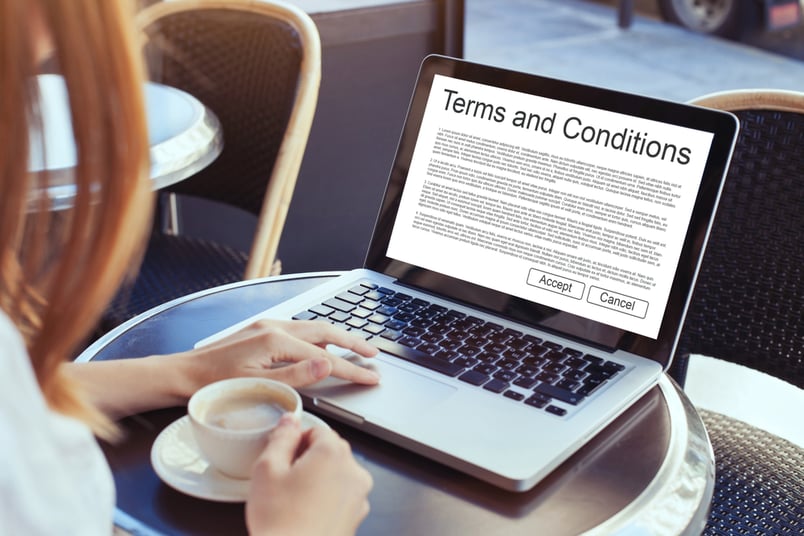Avoiding pitfalls while writing End-User License Agreements (EULA) is similar to preventing issues with most other types of contracts. The contract needs to avoid ambiguous or illegal clauses, cover regulatory necessities, and consider its audience. As the EULA covers consumers without legal knowledge, keeping these contracts short and concise is ideal.

However, this can be challenging when a myriad of issues require coverage. Attorneys may err on the side of caution and choose to include as many sections as possible to cover all of their bases. Unfortunately, some courts have found these extensive agreements unenforceable—to the detriment of the companies that drafted them. Artificial intelligence (AI) helps bridge the gap between enforceable EULAs and consumer understanding.
Tips for Avoiding Pitfalls Writing End-User License Agreements
The best solution for avoiding pitfalls in writing EULAs is awareness. It's possible to get ahead of many of the issues that could create problems later by going over them in advance.
Problem
|
Solution
|
Excessive length
|
There's a reason that EULAs are often called "click-through" agreements. Users click through them without reading them because of their excessive length. Keeping EULAs as short as possible to fit the necessary purpose helps to dissuade skimming.
|
Ambiguous terms
|
Vague, confusing phrasing and ambiguous terms will not support the EULA’s intent. Aiming for a layperson's language over legalese can help eliminate many issues.
|
Unenforceable clauses
|
When trying to preserve the integrity of their software, many developers become overzealous and create problems. Terms that undermine free speech rights or create unfair competition cannot be enforced. Agreements should focus on protecting the software, not controlling user behavior.
|
Insufficient disclosures
|
Companies that wish to collect the data of consumers using software usually have to meet specific disclosure requirements. A section should clearly explain why data is collected, how it's used, and where it's stored.
|
Out-of-date language
|
An updated EULA should accompany any change in terms and conditions or software. As companies are required to manage many updates, it can be challenging to schedule them. Ideally, these EULAs should be scheduled to mirror the updates.
|
Above all, companies should remember the target audience of the EULA. Many of the most common contract writing challenges arise because a company tries to be too technical in its wording. This can result in large, difficult-to-understand contracts that threaten the EULA's accuracy and create significant problems for the company.
EULAs and the Contract of Adhesion
EULAs are often contracts of adhesion because they fit the primary criteria. The contracts are issued to thousands of people using identical terms. They occur in "take it or leave it" scenarios, as the user either must accept the terms or not use the software. Finally, they happen between a layperson and a company employing sophisticated attorneys to draft the EULAs.
When adhesion contracts are in play, there is an increased responsibility to ensure the contract is accurate and fair to the user. However, creating expert agreements that eliminate ambiguities and cover all the necessary regulatory requirements is not easy. Additionally, legal teams are often required to manage thousands of contracts. AI offers a solution to these issues.
How AI Overcomes EULA Challenges
AI provides a solution to managing the pitfalls of writing End-User License Agreements by allowing the creator to leverage the data of other successful contracts. It can also help agreements stay up-to-date throughout subsequent changes to the terms and conditions of the software.
Here's how an AI-driven solution works:
- The AI “remembers” data related to successful EULAs and other company-specific information. It uses machine learning, natural language processing, and predictive analytics to perform like a top-level attorney.
- The legal team submits their EULA for review. The AI compares the contract to the information garnered in the first step. The review is completed in a matter of minutes.
- The legal team receives a marked-up copy of their EULA with suggestions and revision ideas. With the best AI programs, legal staff will receive specific language and clause sections to add.
- The legal team accepts the suggested changes.
These steps are similar to the ones any competent legal department would complete, but with the help of AI they are accomplished in minutes without human review. The AI can use its repository of data to predict outcomes based on historical information and ensure the contract reviewers are empowered to make the best decisions.
Avoiding the pitfalls of writing End-User License Agreements does not have to be a burdensome task. By taking advantage of AI legal technology, companies can create more succinct, straightforward contracts that provide all the necessary legal protections.
LexCheck's platform can help you avoid the pitfalls of writing End-User License Agreements with our detailed contract review process. To see the technology in action, reach out to sales@lexcheck.com or request a demo.
.jpg)
